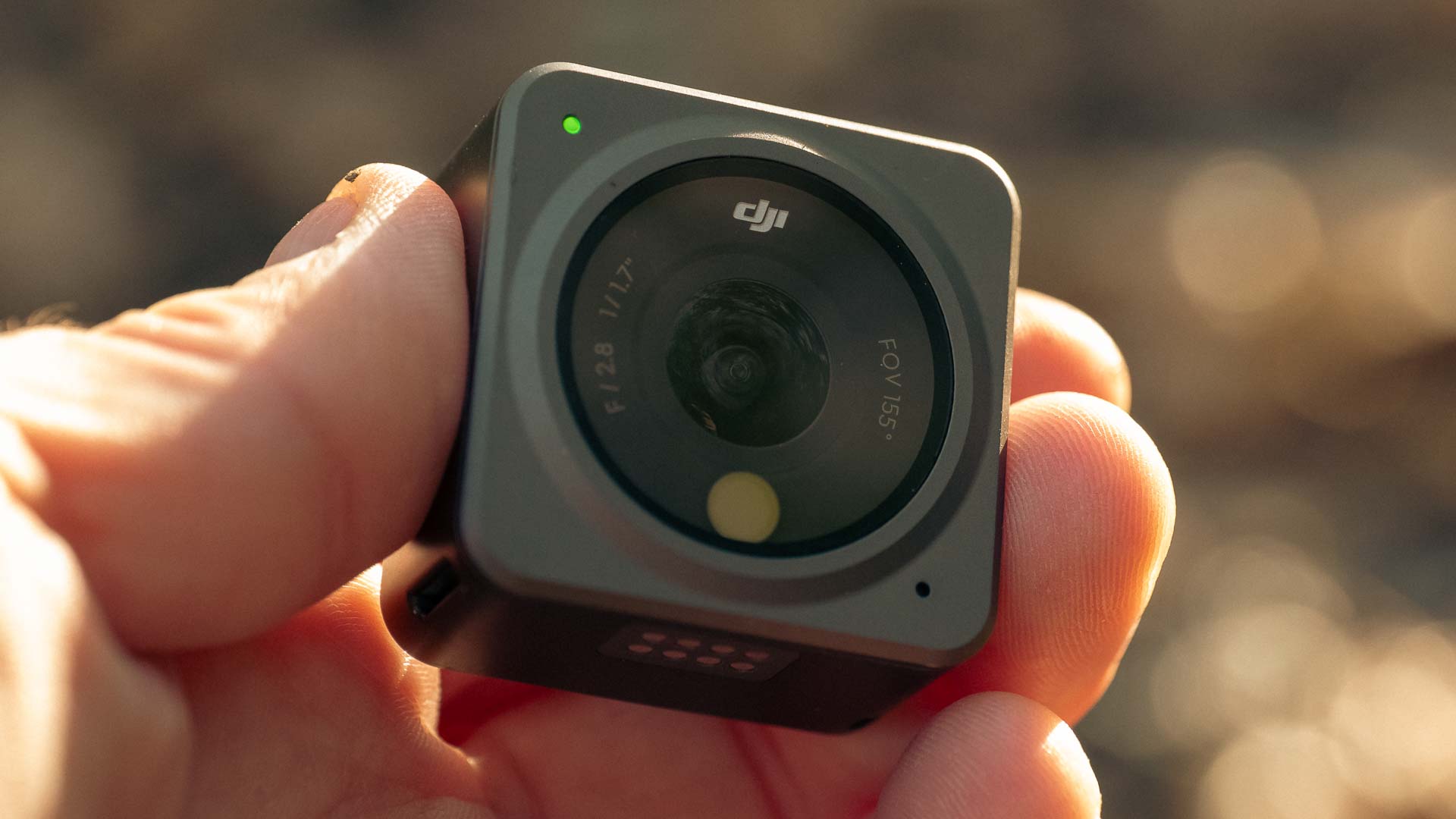
The DJI Action 2 is a long-awaited sequel to the OSMO Action. But does it live up to expectations? Here's our DJI Action 2 review.
The Action 2 has had a lot of expectations placed upon it. DJI's first foray into the action camera genre, the OSMO Action, was very well received and has become a favourite amongst some users.
When I originally looked at the OSMO Action I found it to be a capable camera, but with some limitations, primarily the comparatively narrow field of view versus some of the competition.
The DJI Action 2 corrects this with an ultra-wide 155-degree FOV, but it also takes the form of an entirely new design paradigm; modularity.
Insta360's ONE R was the first modular action camera, enabling users to choose between using it as a 360 camera, a traditional action camera, and a 1-inch sensor Vlogging machine. It was put together in three pieces, including the battery and then secured together with an outer frame, which allowed it to be attached to different mounts. The Action 2 is a much simpler affair that consists of two parts, and it fundamentally changes things. But first, let's begin from, well, the beginning.
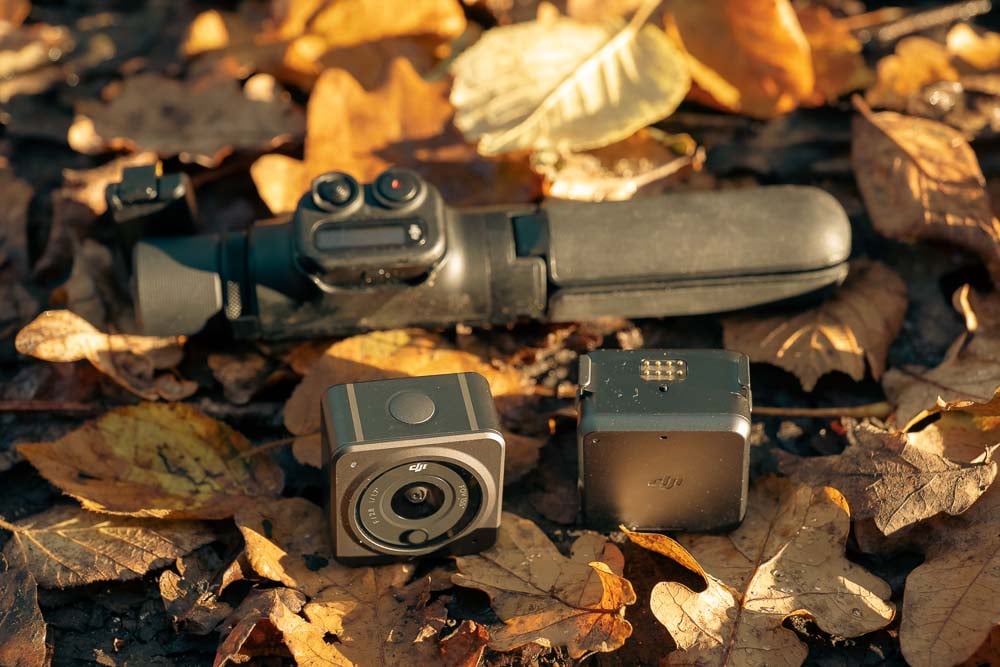
The DJI Action 2 with its power module on the right, and behind, the selfie stick with wireless remote.
First impressions
The DJI Action 2 is packaged very nicely together. The review unit was sent to us unopened, so I got to experience the 'all-new' effect.
The camera unit and its modules are beautifully made, with what seems to be a milled aluminium body. The camera unit has a single button, which functions as a power button and a record start/stop button.
The front of the unit consists of the lens, which is covered by protective glass. Below the lens is a white disc. This is the colour temperature sensor, which DJI claims helps the camera deal with mixed lighting situations better.
The body and the modules fit together with magnetics combined with two small clips that fall into place on either side, gripping the units together. The magnets seem pretty strong, and it is pretty much impossible to pull apart when the two side clips are in place. However, if one of them doesn't engage, the unit can be pulled apart reasonably easily, and I have encountered a few occasions where both of them didn't engage until I pushed them in manually.
In general, though the build quality cannot be faulted, the design of Action 2 is beautifully simple from an aesthetic point of view, and really does look great, as well as feeling good to hold, if a little slippery due to the smooth sides.
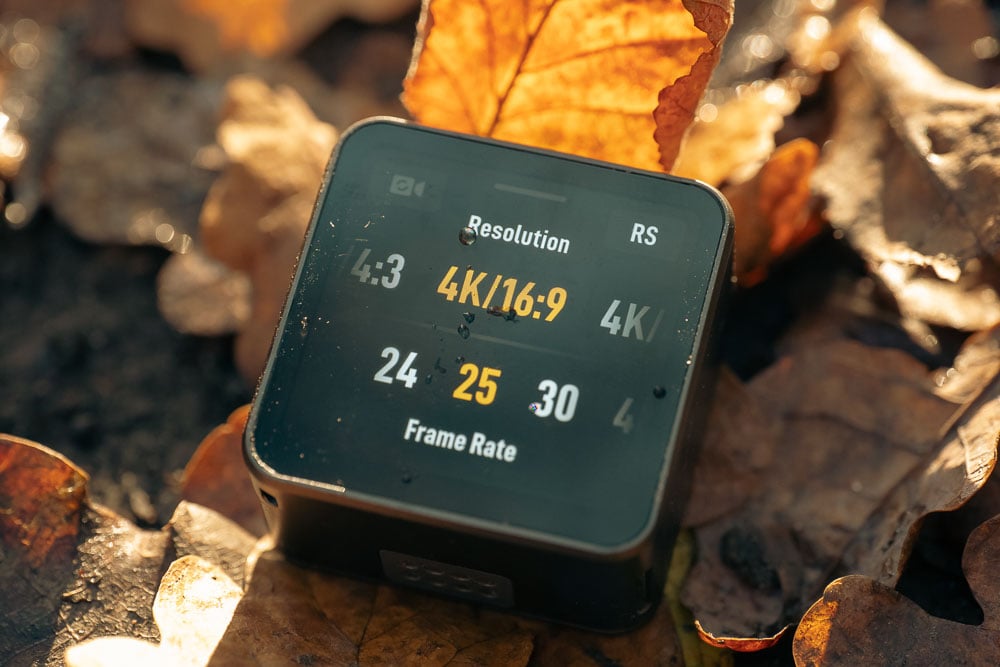
The rear touch screen on the Action 2 is easy to use and responsive. The user interface is very clear and easy to read.
Power on
The Action 2 powers on very quickly indeed. The LCD screen on the rear of the camera unit and on the front-facing LCD touchscreen module is bright and clear. Touch response is also pretty good, and the interface is easy to navigate.
Image mode selections are very clear, with large yellow text making it easy to read the mode you are choosing. Turning the camera on and off is matched with haptic feedback, and recording is marked with an audio indication.
In general use, the Action 2 is fluid to use, and it's a good user experience; however, there are some flaws to the system that become apparent once you begin to use the camera in its primary intended environment.
First, the good bits
I'll come to the camera's limitations in just a moment, but before I do, it's only fair that I talk about what I like about it.
The Action 2 camera unit is very small and light, and easily pocketable. So if you want to grab a camera that you can carry unobtrusively on your holidays, this is easy to do. It's not quite as compact or as protected as Insta360's GO 2, but it's still extremely easy to carry. Although I would be careful of things like keys and coins being in the same pocket.
The image quality from the system is excellent. DJI's involvement with Hasselblad has really paid off in recent years, and the colour science on the Action 2 is no exception. So whether you use it in the standard colour mode or in D-Cinelike and grade it, the colour reproduction is very pleasing to the eye and very natural. It can have trouble with very highly saturated reds going a bit towards pink, but it's easy to correct in editing. Colours like this cause trouble for cameras across the board, and it's a tricky one to get right.
Sharpness is generally good, and although you have no control over the digital sharpness settings, it does come set at a point where the image looks good and not overtly harsh and digital. Although I would like to see some control over this in a future firmware update to dial it down just a little bit for intercutting with other cameras.
One firmware solvable niggle that I have is that it isn't possible to lock the exposure. Simply adding the ability to long press on a portion of the screen to do this would be useful in many circumstances.
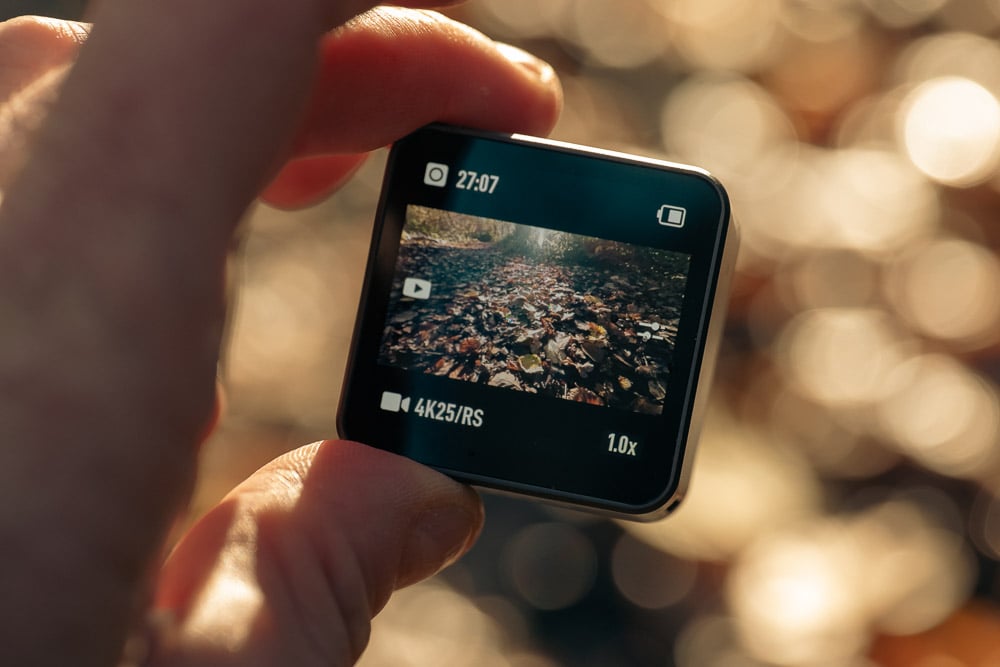
The Action 2 camera unit is tiny.
The wide angle lens is beautiful
I love the wide-angle lens. For me, this is the stand out feature of the camera that I really, really like. DJI has knocked it out of the park here. For POV shots, the ultra-wide setting is superb, particularly if you use the 4:3 aspect for extra height and then perform a dynamic stretch in post. Even with the RockSteady stabilisation switched on, the FOV is on par with the GoPro with the Max Lens Mod attached, except that instead of 2.7K, the Action 2 is recording a full 4K.
In fact, even when you put the Action 2 into Standard De-warp mode, which eliminates the curved fisheye effect, the FOV is still only just shy of the width of the HERO10's FOV when it is set to wide.
So, from an optics point of view, the DJI Action 2 is a winner, with the camera producing a noticeably wider FOV than the GoPro for a similar amount of general stabilisation. In addition, the DJI's RockSteady stabilisation system performs incredibly well. Even during POV usage, I didn't notice any odd pans or movements that used to occur on the original OSMO Action. It's easily on par with HyperSmooth, and initially seemed to iron out more vibration and small movement. Although I haven't compared it to the recent GoPro update, which improved some aspects of HyperSmooth on the HERO10, and focussed specifically on improving small movement isolation.
Performance-wise, the Action 2 can't really be faulted. Of course, there are the usual low light gripes, but honestly, it's a small sensor action camera. If you want low-light, buy a Sony A7S! Okay, that's a little harsh, but current tech cannot make cameras like these low-light marvels yet.
When you turn the camera on and off, the haptic feedback is helpful when mounted onto a helmet, although it would be nice to have some different haptic feedback when you start and stop recording. I found that I couldn't hear the recording bleeps very well around moving water on the river whilst mounted to a helmet, and there's no volume adjustment. So occasionally, I had to pull over and take my helmet off to check whether I was recording or not since it was easy to end up 'out of sync,' as it were. That is to say, stop recording when you think you are starting it, and vice versa.
But while the images that come out of the camera are very good, the system's modular design causes a few problems. They're not problems that couldn't be solved with a little thought, but at least as the camera stands it can limit things a bit.
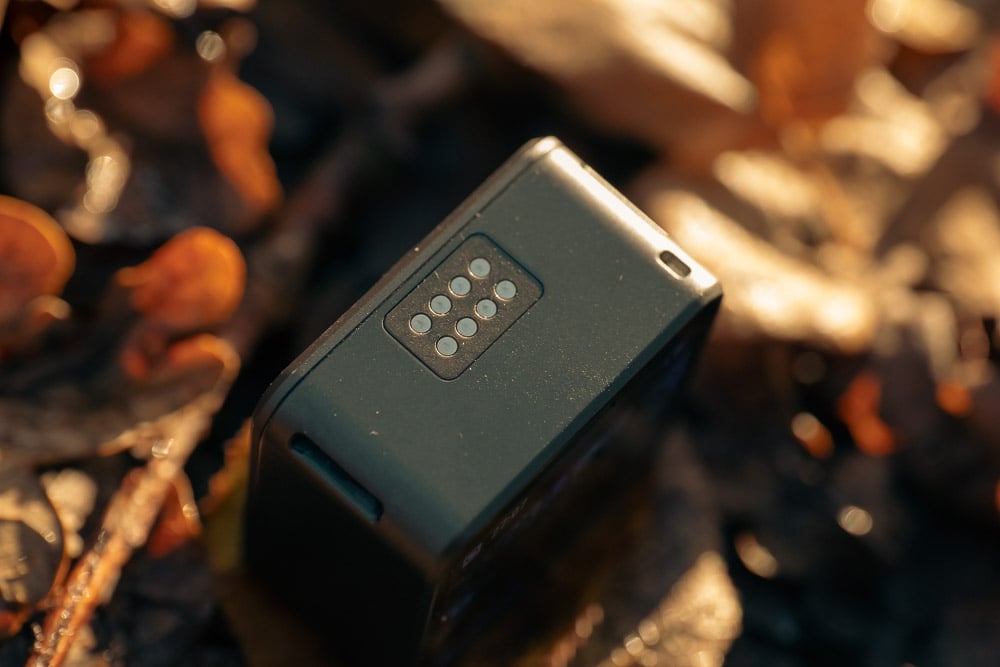
The contact pins on the underneath of the DJI Action 2 camera module.
DJI Action 2 limitations
The limitations of the Action 2 become apparent once you begin using it on different mounts and in different scenarios, and I have to be honest; I'm not sure I fully understand the decision to make the Action 2 modular. With the Insta360 ONE R, there was a purpose behind it, to give the system totally different uses, such as for 360 capture or traditional action camera capture. Instead, the Action 2 has effectively taken a traditional action camera and split it in half for no truly apparent advantage.
The first limitation is that only the camera unit is waterproof, but the other modules are not due to exposed ports. Second, the camera unit has its own internal storage, a very limited 22GB of usable space, and its own internal, non-swappable battery.
This immediately brings problems if you want to use the camera unit as a helmet camera or for watersports of any kind over extended periods. Once that storage space is used up, the only way to clear it is to offload it to one of the other non-waterproof modules with an SD card inserted. And this transfer process is incredibly slow*. In fact, with exposed USB-C ports and a non-sealed SD card slot, you will likely need the waterproof housing even for filming in the rain when using modules.
Furthermore, the camera unit can only be charged using one of the additional modules. The only way to use the Action 2 safely for extended periods around water is to use the optional waterproof case. This brings its own problems, including extra bulk, the risk of fogging up, poor audio recording, and the inability to use the touch screen at all. If you are using the camera inside the waterproof case and you want to quickly switch to 120fps for a slow-motion shot, you won't be able to do this without opening the case. Risky in some environments, and at the very least, introduces the possibility of moisture ingress, increasing the chance of fogging.
Additionally, whether or not you use the Action 2 inside the waterproof housing, you are forced to use it as a vertical stack. This makes using it with the battery module or underwater housing unwieldy for helmet or head-mounted use. Depending on its mounting orientation, the vertical orientation also makes it bulky and either top or bottom-heavy for chest mount use on an MTB.
The lens protection glass for the Action 2 is not user-replaceable. GoPro came in for a whole ton of flack when it removed the replaceable lens protector on the HERO8, but it subsequently re-introduced it with the HERO9. So if you crack or damage the glass on the Action 2, you'll need to send it back to DJI to be repaired. It isn't hydrophobic, either, although that's a comparatively minor gripe. But it does mean you're back to licking it to try and prevent water droplets.
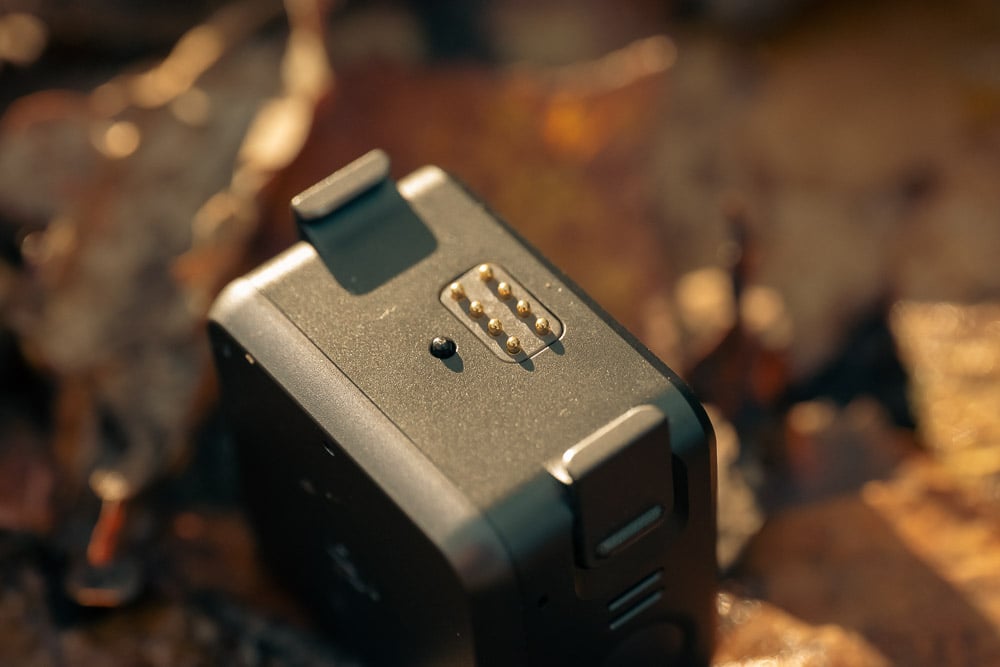
The DJI Action 2 Power Module with the connecting pins and side locking pins.
Battery module
The battery module becomes your spare battery, and to buy a spare one costs £50. So swapping over, if you are recording to an SD card, also means switching the SD card to the new battery or LCD touchscreen module.
Now, regarding some issues, such as the limited recording time on the camera unit, traditional camera users will say it forces you to be more disciplined about what you film. However, this indicates a fundamental lack of understanding about how a lot of users use these cameras, and indeed need to use them.
Nobody is psychic, and nobody knows when something interesting might happen during a river run or when climbing up a rock face. The participant will often want to start the camera running and leave it recording for long periods unless it is for pre-determined action such as a slow-motion shot. But even if you are disciplined, 22GB of storage space for a device that is generally shooting 4K footage, sometimes at up to 120fps, is limiting. The camera unit should really be 64GB at an absolute minimum. If it was, this would fundamentally change things, although it still wouldn't solve the issue of power.
I also encountered a strange problem concerning temperature. For all the talk of overheating issues, which I might add I didn't encounter during regular use, I actually experienced a low-temperature issue.
One of the first things I did with the Action 2 was to take it on a walk up to the summit of Snowdon in Wales. With a 1085m peak in cloud, the view was non-existent, and it was chilly. However, with an air temperature of 3-degrees C and a wind chill of minus 3-degrees C, it was well within the operational abilities of the camera. But it wasn't here that I encountered the problems. It was, in fact, halfway back down.
I decided to shoot some landscape shots with slow movement to check how well the RockSteady 2.0 system performed with slow and small movements. You need to see the LCD screen for this kind of shot, but it was having none of it. The camera flashed up a low-temperature warning, and while it still recorded footage, it switched the LCD off. The air temperature at this point was around 7-8 degrees centigrade.
I asked DJI about this and was told that it's normal behaviour from 0-10 degrees centigrade and that the screen would come back on once it had warmed up. This is little comfort if you happen to be using the camera in a country like Norway in winter and want to get some quick cutaway shots with some sort of composition!
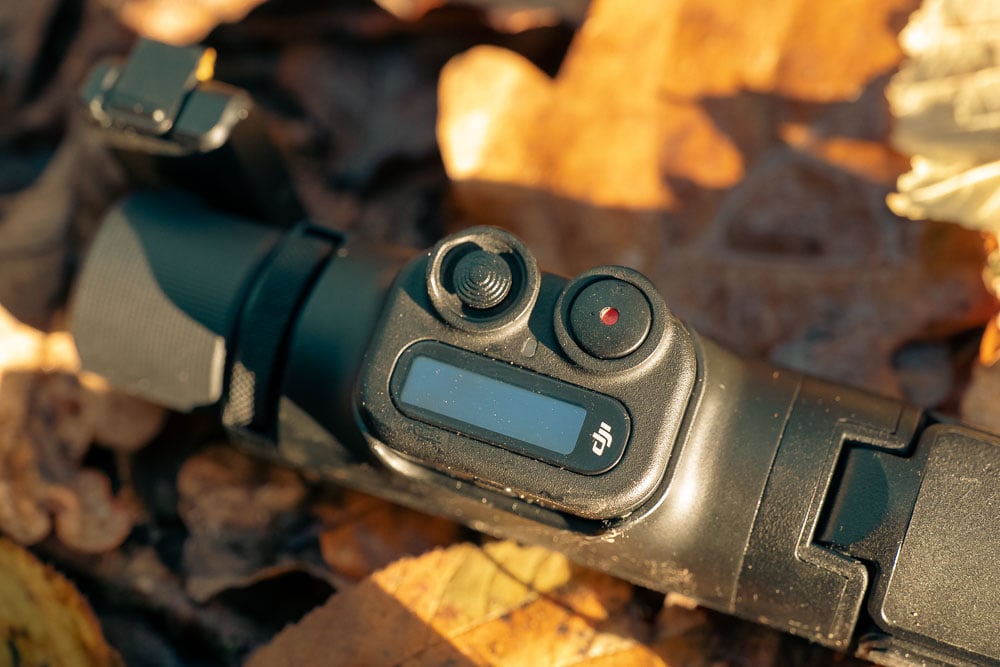
The Action 2 wireless remote can be slow to connect to the camera, and cannot turn the camera on and off, nor change modes.
What can be done?
Not all needs to be lost, however. There may be some ways that DJI can rectify some of these more pressing issues without requiring a complete redesign. My feeling is that once the camera module and secondary module are snapped together, the electrical connecting pins may well be already mostly sealed off from the elements simply because of how hard the two flat surfaces are pushed together. It seems to be the exposed USB-C and SD card slots that are the chink in the waterproof armour.
However, DJI could design slimline frame module that contains a slimline battery to keep the size down, with a small compressible rubber seal around the metal pins, and an integrated SD card slot, and a USB-C port behind a water-sealed door, and perhaps even a small, removable, battery. In addition. The frame (perhaps made out of the same metal as the body) would surround the assembly and lock it together, giving it more security than just magnetics. Many of the current system's faults for high action, mounting, and watersports usage could be solved with such a system. I've provided a concept graphic below as to how this could possibly work. I'm no Photoshop guru, so go easy on my efforts!
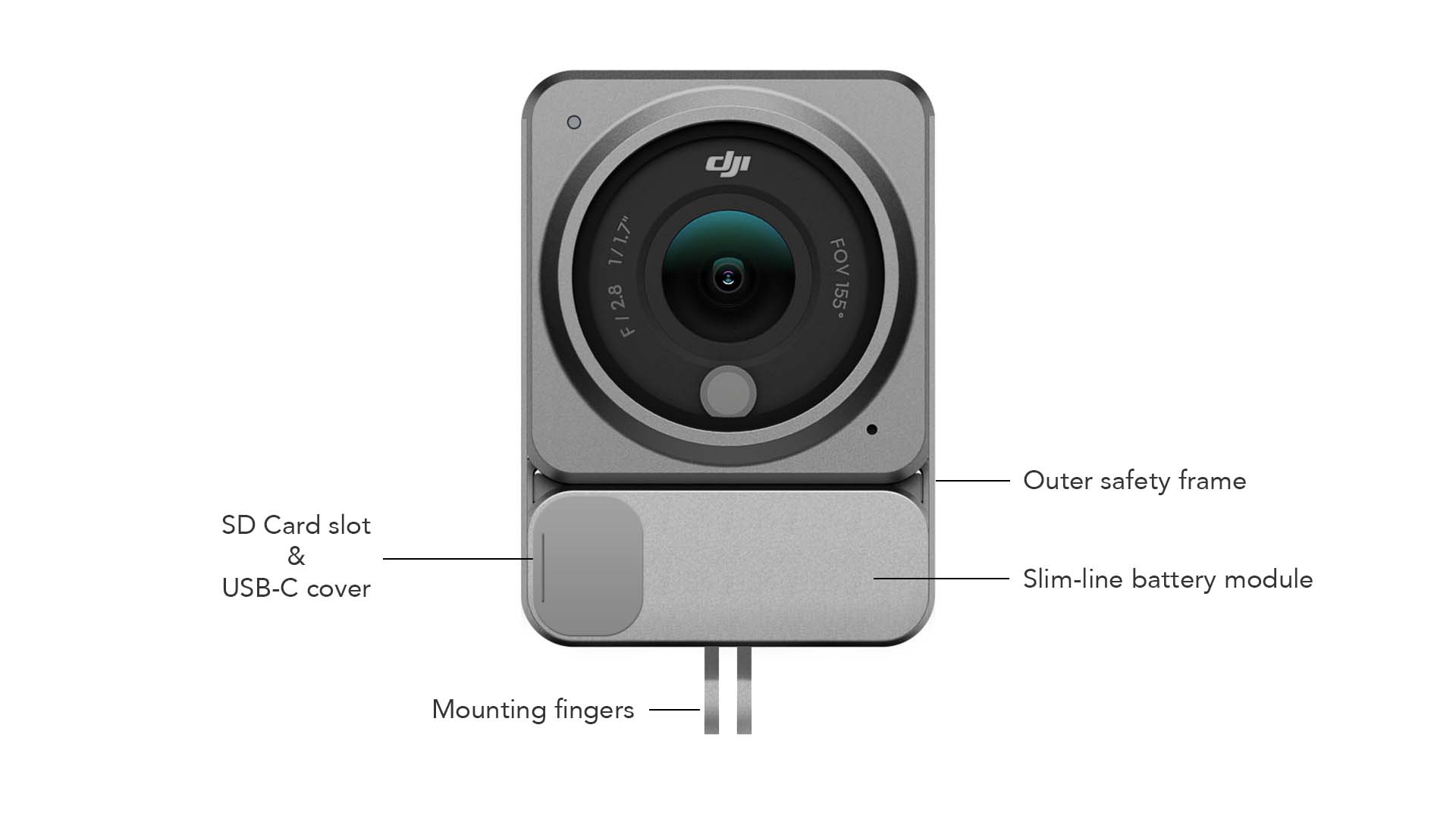
A concept on how an optional 'watersports' module could work with the Action 2, to reduce size, vertical bulk, and eliminate the need for the external housing for surfing etc. A slim-line outer frame keeps it together.
This would ensure that the system remained relatively compact. In addition, the excellent wide-angle lens would finally be usable on the water for more extended trips and POV usage without the need for a bulky housing. Although it would still need to be mounted vertically. Unfortunately, I don't think it would be possible to make the camera capable of horizontal mounting unless the narrower horizon levelling mode is used, due to the sensor orientation.
Conclusions
The Action 2 in its current guise makes for an excellent lifestyle camera, potentially an alternative to Insta360's GO 2. However, the reality is that this is not what the Action 2 was primarily designed to take on. Whilst DJI's promotional material does cover nice, sunny, lifestyle use, it is most certainly being marketed as a 'take anything you can throw at it' action camera.
I find the move to a modular system slightly puzzling since its primary purpose seems to be to allow the camera unit to operate in a much more compact way, a bit like the GoPro Session used to. However, whilst it didn't feature a removable battery, the Session could at least accept an SD card.
The Action 2 looks really cool on paper and in photos, but its practical purpose as an out and out action camera is severely limited at present. If DJI had taken the OSMO Action and added the 4K/120 ability, the new RockSteady stabilisation, and the fantastic ultra-wide lens to it, the Action 2 could have been almost perfect and would have taken the fight directly to GoPro.
If you were to purchase the Action 2's Dual Screen Combo package, which gives the closest match in terms of features to the GoPro HERO10, you'd be paying £455. For the Power Combo, which has no front screen, you'll be paying £349.
As a camera for action sports, the Action 2 is a mixed bag. For dry weather use, it's excellent, and as such, I feel that it will end up being used as a lifestyle camera more than one for out and out action, but at £455, there are much less expensive options out there for this. For travel, too, the Action 2 might find a niche. But with the lack of waterproofing in any module-based configuration, even filming in heavy rain is out of the question without the waterproof housing. This simply must be addressed, along with the forced vertical arrangement of modules.
At RedShark, we always try to take the more pragmatic view of things, taking products on their merits whilst highlighting any genuine problems we find. The Action 2 is different. As a camera designed for out and out action and sports usage, it's a concept that really needed a lot more thought and consideration of what users actually demand from such a camera.
Quite why the module system was designed without waterproofing as an absolute top priority is unfathomable for a camera of this type. If it had been, this review would have taken an entirely different angle, even if there would still be some very minor niggles left.
An action camera doesn't need gimmicks. The OSMO Action got the basics very right. Still, the Action 2, whilst producing a superb image from an absolutely stonkingly good ultra-wide lens, needs a little bit of work to get it to a point where it can really be considered a true action camera.
That said, in situations where it can be used, there are some nice features. Whilst I have my reservations about the magnetic system during intense action, the ability to very quickly swap mounts is really good. And that's the thing, I really want this camera to be great. DJI, please consider the design modifications and suggestions I made above, and I would love to re-visit this!
If you want to find out more about the DJI Action 2, visit the DJI website.
Addendum: Since this review was first written, DJI has released a firmware update that improves exposure performance, as well as telling users average record times at a given temperature.
Correction: The original version of this review stated that the camera module had no tether points. This is incorrect, and in fact there are some tiny tether/lanyard feed holes on the bottom corner of the camera unit.
Tags: Production Review Action cameras


Comments